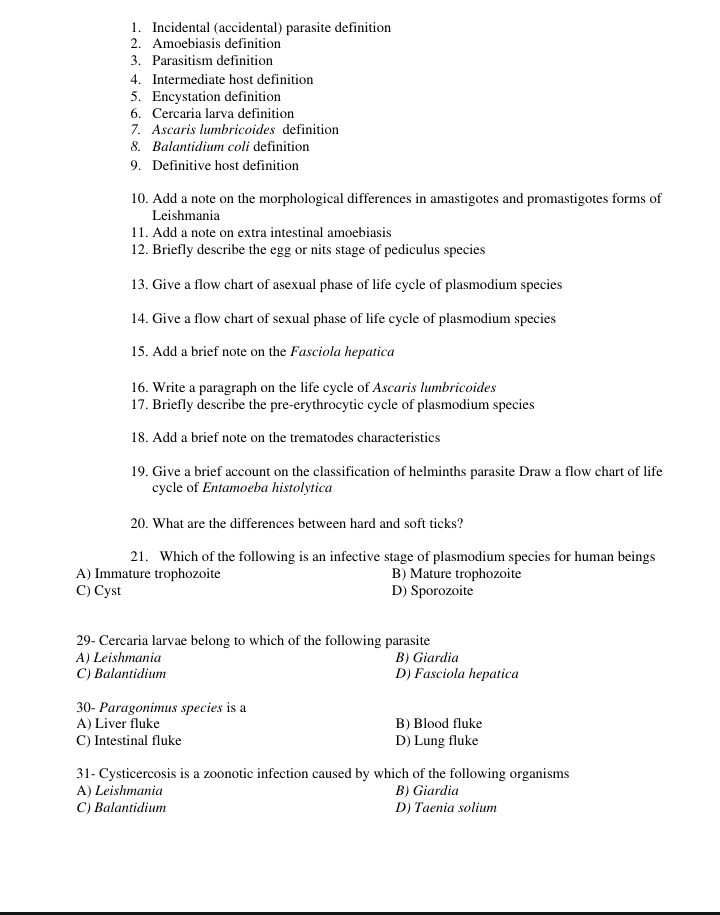1. Incidental (accidental) parasite definition. 2. Amoebiasis definition. 3. Parasitism definition. 4. Intermediate host definition. 5. Encystation definition. 6. Cercaria larva de... 1. Incidental (accidental) parasite definition. 2. Amoebiasis definition. 3. Parasitism definition. 4. Intermediate host definition. 5. Encystation definition. 6. Cercaria larva definition. 7. Ascaris lumbricoides definition. 8. Balantidium coli definition. 9. Definitive host definition. 10. Add a note on the morphological differences in amastigotes and promastigotes forms of Leishmania. 11. Add a note on extra intestinal amoebiasis. 12. Briefly describe the egg or nits stage of pediculus species. 13. Give a flow chart of asexual phase of life cycle of plasmodium species. 14. Give a flow chart of sexual phase of life cycle of plasmodium species. 15. Add a brief note on the Fasciola hepatica. 16. Write a paragraph on the life cycle of Ascaris lumbricoides. 17. Briefly describe the pre-erythrocytic cycle of plasmodium species. 18. Add a brief note on the trematodes characteristics. 19. Give a brief account on the classification of helminths parasite. Draw a flow chart of life cycle of Entamoeba histolytica. 20. What are the differences between hard and soft ticks? 21. Which of the following is an infective stage of plasmodium species for human beings? A) Immature trophozoite B) Mature trophozoite C) Cyst D) Sporozoite. 29. Cercaria larvae belong to which of the following parasite? A) Leishmania B) Giardia C) Balantidium D) Fasciola hepatica. 30. Paragonimus species is a A) Liver fluke B) Blood fluke D) Lung fluke. 31. Cysticercosis is a zoonotic infection caused by which of the following organisms? A) Leishmania B) Giardia C) Balantidium D) Taenia solium.

Understand the Problem
The question is a comprehensive examination covering definitions, life cycles, and characteristics of various parasites including protozoa, helminths, and their classifications. It asks for descriptions, flow charts, and comparisons related to different parasitic organisms and their stages.
Answer
1. Incidental parasite: Unusual host. 21. Sporozoite; 29. Fasciola hepatica; 30. Lung fluke; 31. Taenia solium.
- Incidental parasite: A parasite in a host where it's not normally found. 2. Amoebiasis: An intestinal illness by Entamoeba histolytica. 3. Parasitism: A relationship where one organism benefits at the expense of another. 4. Intermediate host: Hosts the parasite during its larval or asexual stage. 5. Encystation: Formation of a cyst by some parasites for protection. 6. Cercaria larva: A free-swimming larval stage of certain flukes. 7. Ascaris lumbricoides: A large roundworm infecting the intestine. 8. Balantidium coli: A ciliate protozoan causing balantidiasis. 9. Definitive host: The host in which a parasite reaches maturity. 10. Amastigotes are the intracellular form in tissues with no flagella, while promastigotes are flagellated forms found in the sandfly vector. 11. Extra intestinal amoebiasis occurs when the parasite spreads to other organs like the liver. 12. Nits of Pediculus species are oval, white, and attached to hair shafts. 13. Asexual stage: Sporozoites enter human, develop into schizonts, release merozoites. 14. Sexual stage: Merozoites form gametocytes, taken by mosquito, develop in the gut. 15. Fasciola hepatica: A liver fluke that infects the liver of various mammals. 16. The life cycle of Ascaris lumbricoides involves ingestion, intestinal maturation, lung migration, maturation in intestines. 17. Pre-erythrocytic cycle: Sporozoites infect liver cells, develop into schizonts, release merozoites. 18. Trematodes: Flukes with flat, leaf-shaped bodies and suckers for attachment. 19. Helminths are classified into cestodes, trematodes, and nematodes. Entamoeba histolytica life cycle includes cysts, trophozoites, and colonization. 20. Hard ticks have a hard shield, while soft ticks lack it and have a leathery appearance. 21. D) Sporozoite; 29. D) Fasciola hepatica; 30. D) Lung fluke; 31. D) Taenia solium.
Answer for screen readers
- Incidental parasite: A parasite in a host where it's not normally found. 2. Amoebiasis: An intestinal illness by Entamoeba histolytica. 3. Parasitism: A relationship where one organism benefits at the expense of another. 4. Intermediate host: Hosts the parasite during its larval or asexual stage. 5. Encystation: Formation of a cyst by some parasites for protection. 6. Cercaria larva: A free-swimming larval stage of certain flukes. 7. Ascaris lumbricoides: A large roundworm infecting the intestine. 8. Balantidium coli: A ciliate protozoan causing balantidiasis. 9. Definitive host: The host in which a parasite reaches maturity. 10. Amastigotes are the intracellular form in tissues with no flagella, while promastigotes are flagellated forms found in the sandfly vector. 11. Extra intestinal amoebiasis occurs when the parasite spreads to other organs like the liver. 12. Nits of Pediculus species are oval, white, and attached to hair shafts. 13. Asexual stage: Sporozoites enter human, develop into schizonts, release merozoites. 14. Sexual stage: Merozoites form gametocytes, taken by mosquito, develop in the gut. 15. Fasciola hepatica: A liver fluke that infects the liver of various mammals. 16. The life cycle of Ascaris lumbricoides involves ingestion, intestinal maturation, lung migration, maturation in intestines. 17. Pre-erythrocytic cycle: Sporozoites infect liver cells, develop into schizonts, release merozoites. 18. Trematodes: Flukes with flat, leaf-shaped bodies and suckers for attachment. 19. Helminths are classified into cestodes, trematodes, and nematodes. Entamoeba histolytica life cycle includes cysts, trophozoites, and colonization. 20. Hard ticks have a hard shield, while soft ticks lack it and have a leathery appearance. 21. D) Sporozoite; 29. D) Fasciola hepatica; 30. D) Lung fluke; 31. D) Taenia solium.
More Information
Parasitic infections often involve complex life cycles with multiple hosts, stages, and adaptations to survive and reproduce.
Tips
Misidentifying stages in parasitic life cycles can lead to incorrect diagnoses.
Sources
- Parasitology Glossary - USF Health - health.usf.edu
- Amebiasis Fact Sheet - NY Department of Health - health.ny.gov
- Parasitology | The Carter Center - cartercenter.org
AI-generated content may contain errors. Please verify critical information